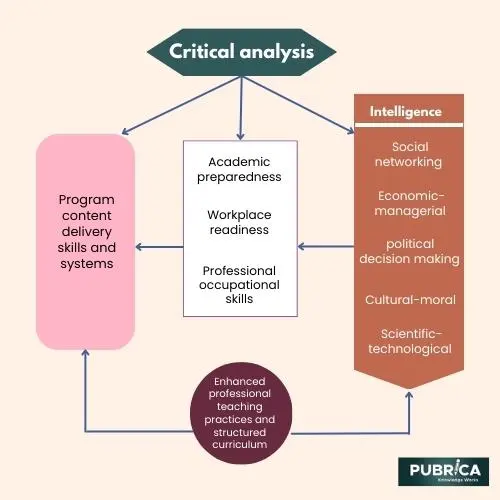
Important Factors Affecting Journal Selection Decisions By Researchers
March 15, 2023
Give an Example of Studies that used the QUADAS-2 tool?
March 31, 2023In brief
When organizing and documenting your work for a study or original research article, visualize using a theoretical structure. A theory framework can assist you in adhering to the standards set forth by the research community, enabling you to share your study and use the results in a dissertation. This blog defines a theoretical framework, when you might use one, and how to build one step-by-step.
Introduction
Researchers use theoretical frameworks to describe the ideas they apply to their work and to contextualize them by highlighting the underlying presuppositions. Although it can be included as a separate chapter or part, a theoretical framework is frequently incorporated into the literature review portion at the start of a paper or experiment(1).

A theoretical framework gives the study a conceptual framework and directs the study’s planning and data analysis. To create a theoretical foundation for research, take these steps:
- Identify the research problem and questions: The research issue and questions should be the foundation for developing the theoretical framework. The first stage in developing a theoretical framework is to specify your study goal, after which you should collect evidence. Then, think about your goals for your research and the unique knowledge you want to contribute to the field.
- Identify critical concepts: Identify the main ideas involved with the research issue and queries. The theory foundation will be built on these ideas. A question you hope to answer with the findings of your study is known as a research topic. These inquiries frequently serve as the foundation for your ideas or assumptions. They may help your viewers understand the research goal and the data you’re looking for. This can help your viewers understand whether your research was a success.
- Review existing literature: To find theoretical models, ideas, and theories that are pertinent to the research, review the body of literature that is related to the important concepts. Once your objectives are clear, you can create a problem statement that outlines the goals of the research and the issues it is intended to address. For example, if you’re looking into Mars’ moons, you might formulate an issue statement along these lines.
- Select a theoretical model or theory: Choose the most relevant to the research issue and research questions based on the literature study.
- Develop hypotheses or research questions: Create hypotheses or research questions that can be evaluated in the study based on the academic model or theory that has been chosen.
- Define the variables: Based on the chosen theoretical model or theory, define the factors used in the research.
- Map out the relationships: Based on the chosen theoretical model or theory, chart the connections between the factors. This will aid the creation of an emotional framework.
- Refine the theoretical framework: Based on pre-testing and input from subject-matter specialists, improve the theoretical structure.
An overview of all the research you read before conducting your research is known as a literature review. It compiles essential sources on a subject and describes how your study fits with those sources’ and other scholars’ theories and how you’re drawing on their work to form your theories. Remembering that the theoretical framework is not a fixed document and can be changed in light of the study’s results is essential(2).
How to create a theoretical framework
The basics of a theoretical framework include the following:
| Definitions of terms | Explanations of theories | Logical connections |
| This helps identify important ideas and defines any unfamiliar terms, expressions, or words in your document to give the reader a foundation for comprehension and a point of reference. | Each of the theories you intend to use should be explained in your theoretical framework and how they relate to your study. | A theoretical framework should link ideas, terminologies, and theories to make them simple to read and comprehend. This can back your hypothesis when it is being questioned and tested scientifically. |
Benefits of using a theoretical framework
A theoretical framework’s goal is to link your new research to previously known information and to give the reader an explicit declaration of your theoretical presumptions. It lets you set the groundwork for your scientific grand research article, interpret your findings, and draw more significant generalizations(3).
Conclusion
Additionally, a theoretical framework may help structure complicated scientific papers into comprehensible forms. Utilizing a framework allows you to organize your thoughts with relevant research, which can help you understand and apply your ideas to other scholars in related studies.
About Pubrica
The team of researchers and writers at Pubrica creates scientific and medical study papers that can serve as invaluable resources for practitioners and authors. Using the reader to inform them of the gaps in the chosen study area, Pubrica medical writers assist you in writing and editing the introduction. Our specialists are conscious of the order in which the general topic, the issue, and the background are followed by the narrow subject where the hypothesis is stated.
References
Ravitch, Sharon M., and Matthew Riggan. Reason & rigor: How conceptual frameworks guide research. Sage Publications, 2016.
Hughes, Sherick, Thomas E. Davis, and Sitwala N. Imenda. “Demystifying theoretical and conceptual frameworks: A guide for students and advisors of educational research.” J Soc Sci 58.1-3 (2019): 24-35.
Fuertes, Guillermo, et al. “Conceptual framework for the strategic management: a literature review—descriptive.” Journal of Engineering 2020 (2020): 1-21.
